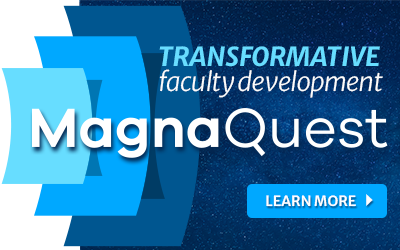Anyone who has ever attended a program advisory committee meeting knows that it can be a mix of exciting inspiration and terrifying fear that one’s programs are not doing enough to prepare one’s graduates. While members of the business community will often give helpful, positive commentary on the knowledge the institution’s graduates bring to the professional environment, they may also pose a problem that the traditional university was never designed to handle: teaching skills in the first or second year of study that will still be cutting-edge and desired by industry at the time of graduation. Welcome to the world of alternative credentials.
At the same time, institutions are increasingly being contacted by working professionals who want to “retool” or update their skills to be more attractive for promotion or increases in responsibility. These working professionals often do not want or need to complete an entire degree to get the value they want from a program, but they do need course options geared to their professional and scheduling needs.
According to “Demographic Shifts in Educational Demand and the Rise of Alternative Credentials,” a report by educational company Pearson and the University Professional and Continuing Education Association (UPCEA), alternative credentials are defined as “competencies, skills, and learning outcomes derived from assessment-based, non-degree activities [that] align to specific, timely needs in the workforce.”
Alternative credentials are an important, growing trend. The Pearson/UPCEA report references IPEDS data that show “an increase in non-degree education awards and certificates from under 600,000 issued in 2001–2002 to nearly 1 million in 2013–2014.” They also cite “a 2014 study by the United States Census Bureau [that] revealed that 30 percent of the adult population now holds an alternative credential.” These credentials, pursued through providers such as Lynda.com, Udemy, Udacity, edX, and other partners and providers, are allowing students to tailor their education to their own needs while being highly responsive to the needs of business and industry.
In fact, alternative credentials are really nothing new to academe. The Pearson/UPCEA report includes non-credit training courses, non-credit certificate programs, CEU courses, and other types of certificate programs as alternative types of credentials, leading to the data point that 94 percent of institutions surveyed offered some type of non-traditional course. In fact, certificate programs, currently considered an alternative credential, “may soon slide from the list of ‘alternative’ programs as [the Pearson/UPCEA] report and others question whether these certificate programs, even online certificate programs, can be considered ‘alternative’ now that the majority of institutions offer them and find them to be essential.” However, the newest types of programs, such as micro-credentials (small blocks of a few courses or modules aimed at a specific need) are some of the fastest growing and garner the most attention.
Disrupting the Diploma
The Pearson/UPCEA report calls this trend “disrupt[ing] the diploma,” and it is easy to see how these programs may change the marketplace for the traditional degree. Some adult learners may pursue an alternative credential instead of completing a partially finished degree or pursuing a higher or additional degree. Some traditional college students may determine that one or more alternative credentials are more useful and more cost effective than a bachelor’s or associate’s degree. The latter may be particularly true of micro-credentialing and its role in preparing students for jobs in specific industries or specific companies.
The demand creates an opportunity for educational institutions willing to step into the market for academic credentials. While some parts of the private sector may be faster to respond to the market, they lack the experience in education needed to deliver successful courses and learning modules. The Pearson/UPCEA report explains that these private sector players “are fast and nimble, often at the expense of learning efficacy, and they generally lack formal education. All these factors combine to present an opportunity for accredited higher education institutions whose core competencies are firmly established, provided they can adapt and rise to the challenge.” However, the report does note the need for institutions to respond by becoming more “learner- and employer-responsive.”
It is not only the opportunity to respond to the needs of learners and employers that makes alternative credentials so attractive. “Non-traditional course offerings are generating a significant amount of revenue for institutions that provide alternative credentials,” the Pearson/UPCEA report says, noting that these courses have generated an average of 81 percent of the survey respondents’ unit revenue. This was true of all institution types; an average of 75 percent of the unit revenue of doctoral institutions in the survey came from non-traditional course offerings, while nearly all (97 percent) of baccalaureate institutions’ revenue did.
Building the Brand
Micro-credentials and digital badges are the hottest growth areas for alternative credentials. Currently, an average of about 20 percent of all institutions in the survey offer digital badges, an area that may overlap somewhat with certificate offerings. Regardless, these offerings are most commonly targeted to the business, education, and technology/IT industries. Colleges and universities are beginning to understand the value of these alternative credentials, “with 39 percent either strongly or somewhat agreeing that their institution accepts alternative credentialing as an important evolving opportunity to better serve its constituents,” the report says.
This presents an opportunity for institutions of higher education to build their brand. The report says, “Because brand recognition is a primary driver of trust in digital credentials, significant opportunities for university-industry co-branding around partnered programs are expected to emerge.” This means that the reputation of the institutions can be used to give the alternative credential increased value while serving to promote the institution’s brand.
The report identifies several factors driving the market for alternative credentials as detailed by a number of leading authors. These include:
- increasing costs associated with higher education;
- a population that is now “buying songs rather than albums” and may increasingly look for a more modular set of products from providers of learning experiences; and
- a series of new technologies fueled by a new high in the level of investment capital in the EdTech industry.”
At the same time, the so-called “skills gap” arises as 96 percent of provosts feel universities are doing a good job of preparing graduates for success in the workforce, while only 14 percent of Americans and 11 percent of business leaders strongly agreed that graduates have the necessary skills and competencies to succeed in the workplace.
With alternative credentials, institutions can have the best of both worlds. Degree programs can continue to focus on developing the theoretical orientation and the broad liberal arts worldview for which these programs have become known. At the same time, alternative credentials can provide nimble, market-responsive training that meets specific needs with prompt turnaround. It is a win/win for one’s institutional mission, one’s students, and one’s bottom line.
Jennifer Patterson Lorenzetti is managing editor of Academic Leader and owner of Hilltop Communications.
Reprinted from Academic Leader, 32.8 (2016): 4, 7. © Magna Publications. All rights reserved.



